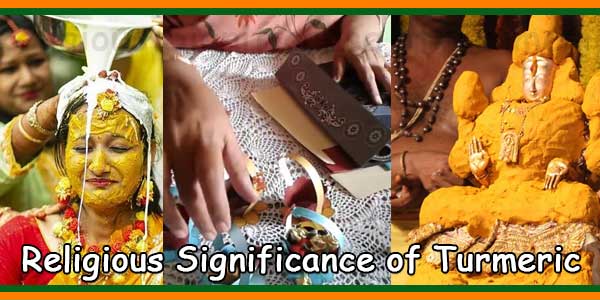Turmeric is a spice widely used as a cooking spice in Indian cuisine. It is one of the most basic Indian spices without which food cannot be cooked in Indian homes. But turmeric is not just a culinary ingredient. Turmeric has many spiritual uses in India. These spiritual uses of turmeric extend to Hindu religious rituals.
Turmeric or Haldi (Hindi) or Manjal(Tamil) or Pasupu(Telugu) as it is called in India also has medicinal powers, Haldi is also the name of a pre-wedding ceremony. During this ceremony (which usually takes place just a day before the wedding), the bride and groom are adorned with turmeric paste and then bathed in milk or water. Turmeric is associated with purity, fertility and auspicious beginnings in Hindu culture. Traditionally turmeric was also used to dye the marriage cloth. It is also intended to relax the bride and groom and dispel any nervousness.
Hindus use turmeric daily basis. Women often apply it to their face in the evening as an act of emulation of the goddess Durga, whose skin emits a yellow glow. Turmeric is also used to color clothes yellow as it is associated with Lord Krishna who is depicted dressed in yellow. Also, some special Ganesh idols are made entirely of turmeric, and turmeric water is used as an offering to Goddess Kali.
Here are some of the spiritual uses of turmeric in Hinduism.
To Adorns The Gods:
Turmeric paste is used to adorn the statues or murtis of Gods and Goddess. For example, Lord Vishnu likes to be decorated with haldi. Three main ingredients are used to adorn the gods, haldi, chandan (sandalwood) and kum kum (vermilion).

Applying on Wedding Cards:
The wedding cards are first marked with haldi and kumkum on the four corners and then distributed to the guests. This shows that turmeric has many spiritual uses in a wedding ceremony.
Using in Wedding Ceremony:
Just before the wedding, a paste of ubtan or turmeric is applied to the bride and groom. This ritual is intended to purify their mind and body before the wedding ceremony. Moreover, turmeric is also a natural ingredient that lightens the skin and cures acne. It also has beauty benefits.
For Tilak:
Indians have a custom of welcoming a person home or saying goodbye to a person by making aarti and tilak or tikka. This tilak is a dot or line drawn on the forehead. This is done for the protection of the person leaving. So when the women of the house make tilak and say God be with you, they use Haldi and kumkum.
Religious:
Art Haldi is often used in conjunction with kumkum to draw religious figures like the swastika, om, etc. These religious symbols are usually drawn with turmeric or vermilion.

